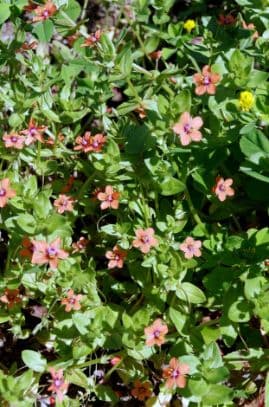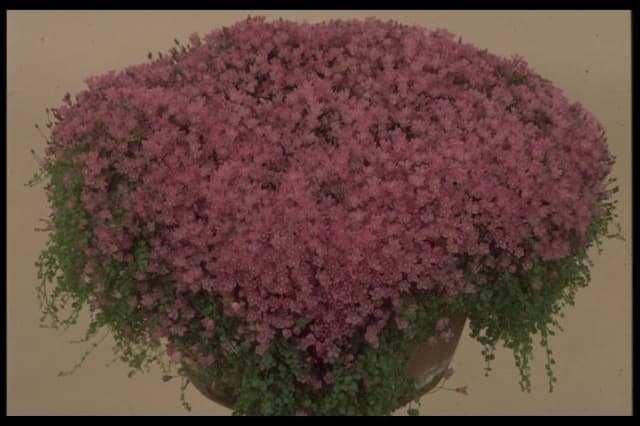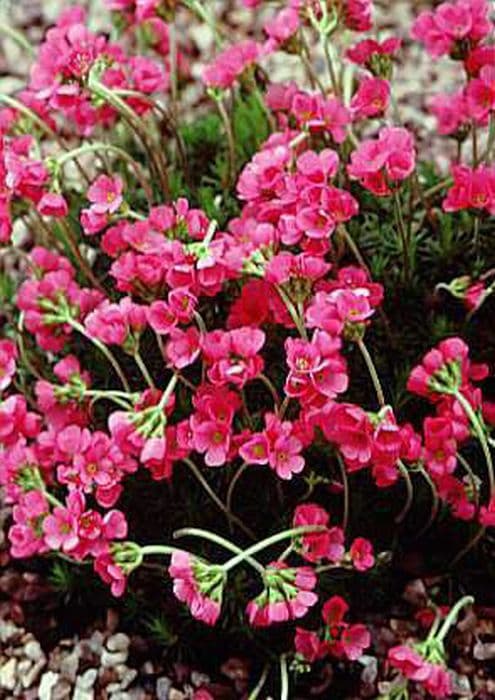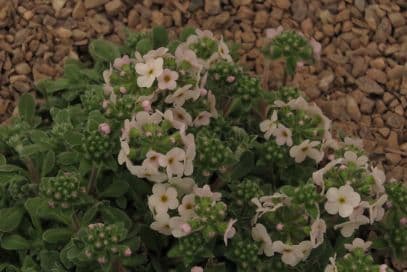Auricula Primula auricula 'C.w. Needham' (Au/a)

ABOUT
The plant known as Auricula 'C.w. Needham' is a particularly striking variety characterized by its unique and vibrant flowers. The blossoms are noted for their ornate appearance, featuring a deeply intense color palette. Each flower consists of a central disc, which is often a contrasting hue compared to the petals that surround it, creating a striking eye-catching effect. These vividly colored petals are typically arranged in a rounded shape, giving the impression of a small, delicate rosette. The foliage of the Auricula 'C.w. Needham' is lush and contributes to its overall charm. The leaves tend to be thick and fleshy, with a slightly waxy texture that adds to their robust nature. They are often a bright green color that forms an attractive backdrop against the dramatic blossoms. This variety is appreciated by gardeners and plant enthusiasts for its decorative appearance and for the touch of elegance it can bring to a garden setting or when displayed in pots. Overall, the Auricula 'C.w. Needham' delights with its showy and colorful presence, making it a favorite for those looking to add a vivid splash of color to their floral collections.
About this plant
 Names
NamesFamily
Primulaceae
Synonyms
Bear's Ear, Mountain Cowslip, Auricula
Common names
Primula auricula 'C.w. Needham' (Au/a).
 Toxicity
ToxicityTo humans
Primula auricula, commonly known as auricula, is not known to be highly toxic to humans. However, it can cause mild irritation and discomfort if ingested.
To pets
Auricula also poses very limited toxicity risk to pets; ingestion may result in mild gastrointestinal upset, but serious complications are unlikely. It is always advisable to consult a veterinarian if you suspect your pet has ingested any part of a potentially toxic plant.
 Characteristics
CharacteristicsLife cycle
Perennials
Foliage type
Evergreen
Color of leaves
Green
Flower color
Yellow
Height
6 inches (15 cm)
Spread
6 inches (15 cm)
Plant type
Herb
Hardiness zones
5
Native area
Europe
Benefits
 General Benefits
General Benefits- Aesthetic Appeal: Adds vibrant colors and unique patterned foliage to gardens and landscapes.
- Attracts Wildlife: Flowers serve as a food source for pollinators like bees and butterflies.
- Low Maintenance: Requires minimal care once established, making it suitable for gardeners of all skill levels.
- Drought Tolerance: Once established, it can tolerate periods of low water, reducing the need for frequent watering.
- Cold Hardy: Can survive in cooler temperatures, making it a good choice for various climate zones.
- Long Blooming Period: Offers a lengthy display of blooms from spring to early summer.
- Compact Size: Its small stature makes it ideal for borders, rock gardens, and containers.
- Garden Hybridization: Its diverse variations allow for exciting breeding and hybridizing opportunities for enthusiasts.
 Medical Properties
Medical PropertiesThis plant is not used for medical purposes.
 Air-purifying Qualities
Air-purifying QualitiesThis plant is not specifically known for air purifying qualities.
 Other Uses
Other Uses- Photography Prop: The distinct colors and patterns of the Auricula make it a captivating subject for macro and botanical photography.
- Edible Flowers: Although not commonly known for culinary use, the Auricula flowers may be edible and can be used to garnish salads and desserts.
- Botanical Art: These plants are popular subjects in botanical illustration and watercolor painting due to their vibrant and varied hues.
- Living Gifts: Auriculas, with their unique beauty, can be given as thoughtful living gifts for special occasions such as birthdays or Mother’s day.
- Educational Tool: Auriculas can be used in schools and educational programs to teach children about plant biology and hybridization.
- Perfumery: While not one of the main plants used in perfumery, Auricula flowers may contribute a subtle, floral note to custom perfumes.
- Theme Gardens: Auriculas can be used in alpine or rockery theme gardens to create visually appealing displays.
- Crafts: Dried Auricula flowers can be used in crafts, such as in making bookmarks, greeting cards, or potpourri.
- Floral Displays: Auriculas can be part of intricate floral displays and arrangements at horticultural shows and competitions.
- Collectors' Specimens: Auriculas, particularly rare and unusual varieties, are often sought after by plant collectors for their unique traits.
Interesting Facts
 Feng Shui
Feng ShuiThe Primula, commonly known as the Auricula, is not specifically mentioned in traditional Feng Shui practice. However, in Feng Shui, healthy flowering plants like Auricula can contribute to a positive energy flow when placed in the right area of the home or garden, such as the east sector for health and family or southeast for wealth and abundance.
 Zodiac Sign Compitability
Zodiac Sign CompitabilityThe Auricula is not used in astrology practice.
 Plant Symbolism
Plant Symbolism- Paternity: Given the name 'C.W. Needham,' there is an implication of a personal touch or even a dedication, suggesting that this plant could symbolize fatherhood or the connection to a paternal figure.
- Unique Beauty: The Primula auricula, commonly known as 'Auricula' or 'Bear's Ear,' often bears unique and striking patterns on its petals which can represent the beauty of individuality and the appreciation of unique traits in others.
- Endurance: Auriculas are hardy plants capable of thriving in alpine regions, hence they may symbolize resilience, endurance, and the ability to withstand harsh conditions.
- Adaptability: Given its ability to grow in varied environments, the Auricula can represent adaptability and the importance of being versatile in the face of different life challenges.
- Rarity: Some varieties of Auriculas are quite rare and sought after by collectors, symbolizing exclusivity or the value we place on rare and unique objects.
 Water
WaterTo properly water Auricula Primulas, ensure the soil is kept evenly moist but not waterlogged. They should be watered with about one inch of water per week; adjust this amount during hotter, drier weather or if you notice the leaves wilting. Water at the base to keep the foliage dry, which helps prevent disease. During the winter, reduce watering to prevent rot, particularly if the plant is outside in cold temperatures. Overhead watering should be avoided to protect the delicate flowers.
 Light
LightAuricula Primula thrives in bright, indirect light and should be placed in a spot where it can receive morning sunlight and afternoon shade. Avoid placing them in full, direct afternoon sun, especially in warmer climates, which can scorch their leaves. A north-facing or east-facing window is often ideal when grown indoors.
 Temperature
TemperatureAuricula Primulas prefer cool conditions and can tolerate temperatures as low as 20°F and as high as 80°F, although they thrive best between 50°F and 70°F. They can survive a light frost but should be protected from harsh winter winds and extreme cold.
 Pruning
PruningAuricula Primulas benefit from deadheading to encourage more blooms and to maintain a tidy appearance. Prune off spent flowers and any yellowing leaves to promote healthy growth. The best time for pruning is immediately after the flowering period has concluded.
 Cleaning
CleaningAs needed
 Soil
SoilThe best soil mix for Auricula Primrose should be well-draining, loamy, and rich in organic matter. A mix of two parts peat or coir, one part loam, and one part perlite or fine grit can work well. The soil pH should be slightly acidic to neutral, ranging between 5.5 and 7.
 Repotting
RepottingAuricula Primroses should be repotted every one to two years to refresh the soil and accommodate root growth. It's best to repot after flowering, usually in late spring or early summer.
 Humidity & Misting
Humidity & MistingAuricula Primroses perform best in moderate humidity levels. They prefer a humidity range between 50% to 60% if possible. Stagnant air can lead to fungal diseases, so good air circulation is important.
 Suitable locations
Suitable locationsIndoor
Keep in bright, indirect light with cool temperatures.
Outdoor
Partial shade, sheltered from harsh sun and wind.
Hardiness zone
4-8 USDA
 Life cycle
Life cycleThe Primula auricula 'C.W. Needham', also known as Border Auricula, begins its life cycle as a seed, which, when sown in moist soil and with adequate light and warmth, will germinate. Once the seedlings emerge, they grow into a rosette of leaves in their first stage of vegetative growth. As the plant matures, it develops a sturdy stem that bears clusters of ornamental, often fragrant flowers that showcase a variety of colors and patterns, typically in early spring to early summer. After pollination, which is often aided by insects, the flowers will produce seed pods that eventually dry and release seeds for the next generation. Alongside sexual reproduction, Border Auricula can also propagate vegetatively through division of the root clump in late summer or early fall, allowing the cycle to continue with genetically identical plants. In winter, the plant enters a period of dormancy, reducing growth to conserve energy until conditions become favorable for the next growth cycle.
 Propogation
PropogationPropogation time
Spring-summer
Primula auricula 'C.w. Needham', more commonly known as Auricula Primrose, is best propagated by division which is usually done in the late summer after the plant has finished flowering. The clumps of the parent plant are carefully divided to ensure each new section has a piece of the root system attached. Gardeners should gently pull apart the clumps by hand or with the aid of a sharp knife to separate individual rosettes. Each section is then planted in well-draining soil, ensuring the crown of the plant is just above the soil surface to prevent rot. It's important to water these new plants thoroughly after planting to help establish them.









